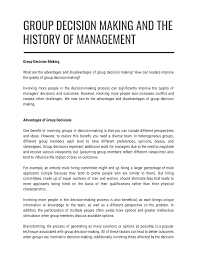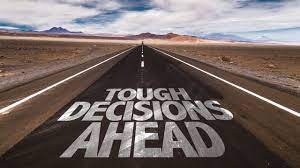Heuristic Decision Making: A Simple Yet Effective Approach
Making decisions can be a daunting task, especially when faced with complex and uncertain situations. However, there is a simple yet effective approach to decision making that can help us navigate through these challenges: heuristic decision making.
Heuristic decision making is an approach that involves using simple rules of thumb or mental shortcuts to make decisions quickly and efficiently. These heuristics are based on our past experiences, knowledge, and intuition. They allow us to make decisions without having to spend a lot of time analyzing all the available information.
One example of a heuristic is the availability heuristic. This involves making a decision based on the information that is most readily available in our memory. For example, if we hear about a plane crash on the news, we may become afraid of flying even though statistically speaking, flying is still one of the safest modes of transportation.
Another example is the representativeness heuristic, which involves making judgments based on how closely something matches our preconceived notions or stereotypes. For instance, if we see someone wearing a suit and tie, we may assume they are successful business professionals even though they could be anything from lawyers to accountants.
While heuristics can be useful in many situations, it’s important to be aware of their limitations. Sometimes our mental shortcuts can lead us astray and cause us to make poor decisions. For example, the confirmation bias heuristic involves seeking out information that confirms our existing beliefs while ignoring evidence that contradicts them.
Despite their limitations, heuristics can still be an effective tool for decision making when used appropriately. By relying on our intuition and past experiences, we can often make quick and accurate decisions without having to spend too much time analyzing all the available information.
In conclusion, heuristic decision making is a simple yet effective approach that can help us navigate through complex and uncertain situations. By using mental shortcuts based on our past experiences and intuition, we can make quick and accurate decisions without having to spend too much time analyzing all the available information. However, it’s important to be aware of the limitations of heuristics and to use them appropriately.
9 Tips for Effective Heuristic Decision Making
- Define the problem clearly and accurately.
- Identify all potential solutions to the problem.
- Evaluate each solution against a set of criteria or values.
- Consider any risks or consequences associated with each solution before making a decision.
- Make sure all stakeholders are consulted in the process, if appropriate and possible
- Take into account different perspectives when evaluating solutions
- Make sure to document your decision-making process for future reference
- Consider any feedback you receive from stakeholders throughout the process
- Be open to revisiting and revising your decision if new information arises
Define the problem clearly and accurately.
Heuristic Decision Making: Defining the Problem Clearly and Accurately
When it comes to making decisions, one of the most important steps is defining the problem clearly and accurately. This is especially true when using heuristic decision making, as relying on mental shortcuts can sometimes lead us to focus on the wrong aspects of a problem.
Defining the problem clearly means identifying what exactly needs to be decided upon. This involves breaking down complex situations into smaller, more manageable parts. For example, if you are trying to decide whether or not to pursue a new job opportunity, you may need to consider factors such as salary, job responsibilities, location, and work-life balance.
Defining the problem accurately means ensuring that you have a complete understanding of all relevant information. This includes gathering data, considering different perspectives, and identifying potential biases or assumptions that may be influencing your thinking.
By defining the problem clearly and accurately, you can ensure that your decision-making process is focused on what really matters. This will help you avoid getting sidetracked by irrelevant details or biases that may lead you astray.
In addition to helping with heuristic decision making, defining the problem clearly and accurately can also help with other types of decision making. It can make it easier to communicate your decision-making process with others and ensure that everyone is on the same page.
In conclusion, defining the problem clearly and accurately is an essential step in any decision-making process. By breaking down complex situations into smaller parts and ensuring that all relevant information is considered, you can make more informed decisions that are based on what really matters. Whether using heuristic decision making or other approaches, this tip will help guide you towards better outcomes.
Identify all potential solutions to the problem.
When it comes to decision making, it’s important to consider all potential solutions to the problem at hand. This is a key tip in heuristic decision making, which involves using mental shortcuts or rules of thumb to make decisions quickly and efficiently.
Identifying all potential solutions allows us to consider a wide range of options and weigh the pros and cons of each. By doing so, we can make more informed decisions that are based on a thorough analysis of all available information.
One way to identify potential solutions is to brainstorm with others. This can be done in a group setting or by discussing the problem with trusted friends or colleagues. By bouncing ideas off of one another, we can come up with creative solutions that we may not have thought of on our own.
Another way to identify potential solutions is to research the problem and its possible solutions. This can involve reading articles or books on the topic, consulting with experts in the field, or conducting experiments or surveys. By gathering as much information as possible, we can ensure that we are considering all potential solutions.
Once we have identified all potential solutions, it’s important to evaluate each one based on its feasibility, effectiveness, and impact. We should also consider any potential risks associated with each solution and weigh them against the benefits.
In conclusion, identifying all potential solutions is an important step in heuristic decision making. By considering a wide range of options and evaluating each one carefully, we can make informed decisions that are based on a thorough analysis of all available information. So next time you’re faced with a decision-making dilemma, take some time to identify all potential solutions before making your final choice.
Evaluate each solution against a set of criteria or values.
When it comes to decision making, using heuristics can be a helpful approach to quickly evaluate options. However, it’s important to not rely solely on mental shortcuts and instead take the time to evaluate each solution against a set of criteria or values.
By establishing a set of criteria or values beforehand, we can ensure that we are making decisions that align with our goals and priorities. For example, if we are deciding between two job offers, we may establish criteria such as salary, work-life balance, and opportunities for growth. We can then evaluate each offer based on how well it meets these criteria.
Taking the time to evaluate each solution against a set of criteria or values can also help us avoid potential biases or blind spots. We may have certain biases or preferences that could lead us to favor one option over another even if it doesn’t meet our established criteria. By evaluating each option objectively based on predetermined criteria, we can make more informed decisions.
In addition, evaluating solutions against a set of criteria or values can help us prioritize our decisions. We may find that some options meet more of our established criteria than others and therefore should be given more weight in our decision-making process.
Overall, while heuristics can be helpful in decision making, they should not be used as the sole means of evaluation. By establishing a set of criteria or values and evaluating each solution against them, we can make more informed decisions that align with our goals and priorities.
Consider any risks or consequences associated with each solution before making a decision.
When it comes to decision making, heuristic approaches can be very useful in helping us make quick and efficient decisions. However, it’s important to remember that these mental shortcuts are not foolproof and can sometimes lead us astray. That’s why it’s important to consider any risks or consequences associated with each solution before making a decision.
When we rely solely on heuristics, we may overlook potential risks or consequences that could arise from our decisions. For example, if we use the availability heuristic to make a decision based on the most readily available information in our memory, we may not consider all of the potential risks associated with our chosen solution.
By taking the time to consider any risks or consequences associated with each solution, we can make more informed decisions that take into account all of the relevant factors. This can help us avoid making hasty decisions that could have negative consequences down the line.
So next time you’re faced with a decision, take a moment to consider any potential risks or consequences associated with each solution before making your choice. This simple step can help you make more informed decisions and avoid any potential pitfalls along the way.
Make sure all stakeholders are consulted in the process, if appropriate and possible
When it comes to making decisions, it’s important to consider all perspectives and ensure that all stakeholders are consulted in the process, if appropriate and possible. This is especially important when using heuristic decision making, as relying solely on mental shortcuts can lead to bias or overlook important information.
Consulting with stakeholders can provide valuable insights that may not have been considered otherwise. It can also help to identify potential risks or unintended consequences that may arise from a decision. By involving all parties in the decision-making process, you can ensure that everyone’s interests are taken into account and that the final decision is fair and equitable.
However, it’s important to note that not all decisions require stakeholder input. Some decisions may be routine or have little impact on others, in which case consulting with stakeholders may not be necessary. It’s up to the decision maker to determine whether stakeholder input is appropriate and feasible for each situation.
In conclusion, consulting with stakeholders can be a valuable part of the heuristic decision-making process. By considering all perspectives and ensuring everyone’s interests are taken into account, you can make more informed decisions and avoid potential pitfalls. However, it’s important to assess each situation individually to determine whether stakeholder input is appropriate and feasible.
Take into account different perspectives when evaluating solutions
When it comes to decision making, it’s easy to get caught up in our own perspective and forget that there may be other viewpoints to consider. This is where the heuristic tip of taking into account different perspectives when evaluating solutions comes into play.
By considering different perspectives, we can gain a more comprehensive understanding of the situation at hand and make a more informed decision. This involves stepping outside of our own biases and preconceived notions and considering the viewpoints of others who may have different experiences or knowledge.
For example, if you are trying to decide on a new marketing strategy for your business, you might consider the perspectives of your customers, employees, and competitors. By taking into account their viewpoints, you can gain valuable insights that may help you make a more effective decision.
It’s important to remember that taking into account different perspectives doesn’t mean you have to agree with them or make decisions solely based on them. Rather, it’s about gaining a more well-rounded understanding of the situation so that you can make the best decision possible.
In conclusion, when using heuristic decision making techniques, it’s important to take into account different perspectives when evaluating solutions. By doing so, we can gain valuable insights and make more informed decisions that take into account all relevant factors. So next time you’re faced with a tough decision, remember to consider all angles before making your final choice.
Make sure to document your decision-making process for future reference
When it comes to decision making, the process is just as important as the outcome. That’s why it’s crucial to document your decision-making process for future reference. This means keeping a record of the steps you took, the information you considered, and the reasons behind your final decision.
Documenting your decision-making process has several benefits. First, it helps you clarify your thinking and ensure that you have considered all relevant information. By writing down your thought process, you can identify any biases or assumptions that may be clouding your judgment.
Secondly, documenting your decision-making process allows you to revisit and reflect on past decisions. This can help you identify patterns in your thinking and behavior that may be hindering your ability to make good decisions. You can also use this information to improve your decision-making skills over time.
Finally, documenting your decision-making process can help others understand how and why a particular decision was made. This is particularly important in group settings where multiple stakeholders are involved. By sharing your thought process with others, you can build trust and transparency in the decision-making process.
In conclusion, documenting your decision-making process is an essential step in making good decisions. It helps clarify your thinking, allows for reflection and improvement over time, and promotes transparency in group settings. So next time you make a big decision, take the time to document your thought process – it could make all the difference!
Consider any feedback you receive from stakeholders throughout the process
When it comes to making decisions, it’s important to consider all the feedback you receive from stakeholders throughout the process. This is especially true when using heuristic decision making, which involves relying on mental shortcuts and intuition to make decisions quickly and efficiently.
Stakeholders are individuals or groups who have a vested interest in the outcome of your decision. They could be employees, customers, suppliers, or anyone else who will be affected by your decision. By listening to their feedback throughout the decision-making process, you can gain valuable insights and perspectives that can help you make a more informed decision.
For example, let’s say you’re considering launching a new product line for your business. Throughout the planning process, you receive feedback from various stakeholders such as customers who express interest in certain features or suppliers who suggest cost-saving measures. By taking this feedback into account, you can make adjustments to your plans that better align with stakeholder needs and preferences.
Ignoring stakeholder feedback can lead to negative consequences such as decreased customer satisfaction or loss of trust among employees. By considering all feedback received from stakeholders throughout the process of heuristic decision making, you can increase the likelihood of making a successful and well-informed decision.
In conclusion, when using heuristic decision making it’s important to consider all feedback received from stakeholders throughout the process. This can help ensure that your decisions are well-informed and meet stakeholder needs and preferences. So next time you’re faced with a tough decision, be sure to listen to what your stakeholders have to say!
Be open to revisiting and revising your decision if new information arises
One of the most important tips for using heuristic decision making is to be open to revisiting and revising your decision if new information arises. While heuristics can be a useful tool for making quick and efficient decisions, they are not foolproof. Sometimes, new information can come to light that may change the context of our decision-making process.
For example, let’s say you are considering purchasing a used car based on its make and model. You may use the representativeness heuristic to assume that because other cars of the same make and model have been reliable in the past, this one will be too. However, if you later find out that this particular car has been in multiple accidents or has had major mechanical issues, it may be time to revisit your decision.
Being open to revisiting and revising your decision is not a sign of weakness or indecisiveness. In fact, it shows that you are willing to adapt to new information and make the best possible decision given the circumstances. It’s important to remember that making decisions is not always about being right all the time; it’s about being able to adjust course when necessary.
In conclusion, while heuristics can be a useful tool for making quick and efficient decisions, it’s important to be open to revisiting and revising your decision if new information arises. By doing so, you can ensure that you are making the best possible decision given all available information. Remember: being adaptable is key when it comes to effective decision-making!




